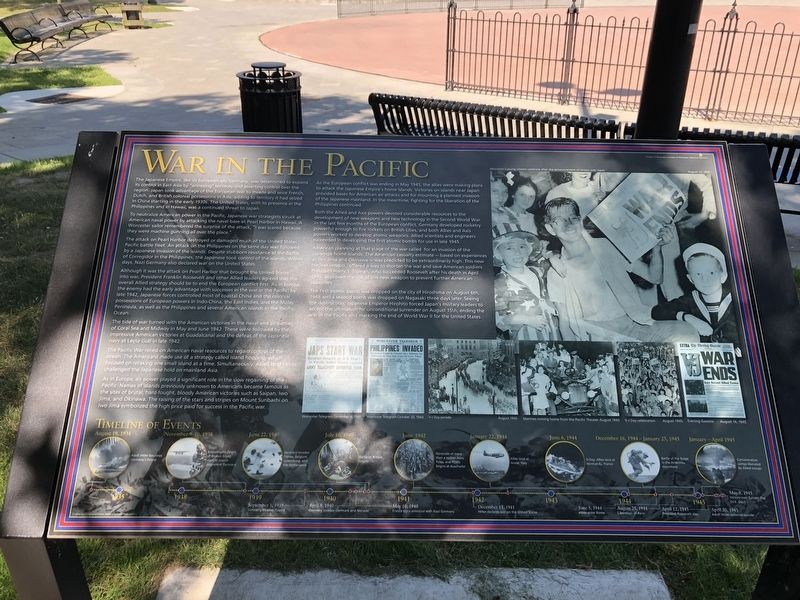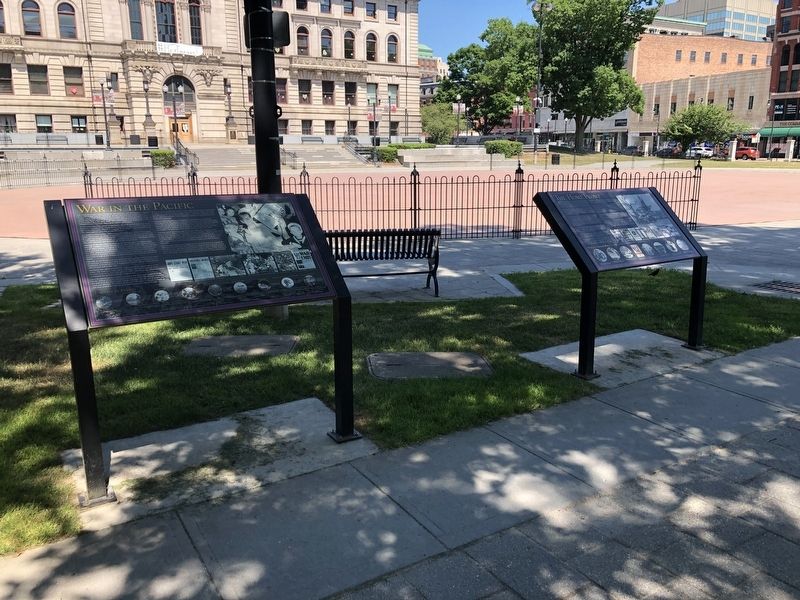Worcester in Worcester County, Massachusetts — The American Northeast (New England)
War in the Pacific
The Japanese Empire, like its European ally Germany, was determined to expand its control in East Asia by "annexing" territory and asserting control over the region. Japan took advantage of the European war to invade and seize French, Dutch, and British colonial possessions in Asia, adding to territory it had seized in China starting in the early 1930s. The United States, with its presence in the Philippines and in Hawaii, was a continued threat to Japan.
To neutralize American power in the Pacific, Japanese war strategists struck American naval power by attacking the naval base at Pearl Harbor in Hawaii. A worcester sailor remembered the surprise of the attack, "I was scared because they were machine gunning all over the place."
The attack on Pearl Harbor destroyed or damaged much of the United States Pacific battle fleet. An attack on the Philippines on the same day was followed by a Japanese invasion of the islands. Despite stubborn resistance at the battle of Corregidor in the Philippines, the Japanese took control of the islands. Within days, Nazi Germany also declared war on the United States.
Although it was the attack on Pearl Harbor that brought the United States into war, President Franklin Roosevelt and other Allied leaders agreed that the overall Allied strategy should be to end the European conflict fist. As in Europe, the enemy had the early advantage with successes in the war in the Pacific; by late 1942, Japanese forces controlled most of coastal China and the colonial possessions of Europe powers in Indo-China, the East Indies, and the Malay Peninsula, as well as the Philippines and several American Islands in the Pacific Ocean.
The tide of war turned with the American visitors in the naval and air battles of Coral Sea and Midway in May and June 1942. These were followed by the impressive American victories at Guadalcanal and the defeat of the Japanese navy at Leyte Gulf in late 1942.
The Pacific War relied on American naval resources to regain control of the ocean. The Americans made use of a strategy called island hopping, which focused on retaking one small island at a time. Simultaneously, Allied land forces challenged the Japanese hold on mainland Asia.
As in Europe, air power played a significant role in the slow regaining of the Pacific. Names of islands previously unknown to Americans became famous as the sites of brutal, hard-fought, bloody American victories such as Saipan, Iwo Jima, and Okinawa. The raising of the stars and stripes on Mount Suribachi on Iwo Jima symbolized the high price paid for success in the Pacific War.
As the European conflict was ending in May 1945, the allies were making plans to attack
Both the Allied and Axis powers devoted considerable resources to the development of new weapons and new technology in the Second World War. In the last few months of the European conflict, Germany developed rocketry powerful enough to fire rockets on British cities, and both Allies and Axis powers worked to develop atomic weapons. Allied scientists and engineers succeeded in developing the first atomic bombs for use in late 1945.
American planning at that stage of the war called for an invasion of Japanese home islands. The American casualty estimate — based on experiences at Iwo Jima and Okinawa — was predicted to be extraordinarily high. This new nuclear weapon offered a way to shorten the war and save American soldiers. President Harry S. Truman, who succeeded Roosevelt after his death in April 1945, approved the use of this new weapon to prevent further American casualties.
The first atomic bomb was dropped on the city of Hiroshima on August 6th, 1945, and a second bomb was dropped on Nagasaki three days later. Seeing the destruction, Japanese Emperor Hirohito forced Japan's military leaders to accept the ultimatum for unconditional surrender on August 15th, ending the war in the Pacific and marking the end of World War II for the United States.
Timeline of Events
August 19, 1934
Adolf Hitler becomes Germany's Führer
November 9-10, 1938
Kristallnacht (Night of Broken Glass) start of Jewish pogrom in Germany
1939
September 1, 1939
Germany invades Poland
1940
April 9, 1940
Germany invades Denmark and Norway
May 10, 1940
France signs armistice with Nazi Germany
June 22, 1940
Germany invades France, Belgium, Luxemburg, and the Netherlands
July 10, 1940
Battle of Britain begins
December 11, 1941
Hitler declares war on the United States
June 1942
Genocide of more than a million Jews, Poles, and POWs begins at Auschwitz
January 22, 1944
Allies land at Anzio, Italy
1944
June 5, 1944
Allies enter Rome
June 6, 1944
D-Day: Allies land at Normandy, France
August 25, 1944
Liberation of Paris
December 16, 1944 - January 25, 1945
Battle of the Bulge in the Ardennes mountains
January - April 1945
Concentration camps liberated by Allied troops
April 12, 1945
President Roosevelt dies
April 30, 1945
Adolf Hitler commits suicide
May 9, 1945
Victory over Europe Day (V-E Day)
Topics and series. This historical marker is listed in these topic lists: Air & Space • War, World II • Waterways & Vessels. In addition, it is included in the Former U.S. Presidents: #32 Franklin D. Roosevelt, and the Former U.S. Presidents: #33 Harry S. Truman series lists. A significant historical date for this entry is January 22, 1944.
Location. 42° 15.729′ N, 71° 48.052′ W. Marker is in Worcester, Massachusetts, in Worcester County. Marker can be reached from the intersection of Front Street and Commercial Street, on the left when traveling west. Touch for map. Marker is at or near this postal address: 99 Front St, Worcester MA 01608, United States of America. Touch for directions.
Other nearby markers. At least 8 other markers are within walking distance of this marker. The Home Front (here, next to this marker); World War II Time Capsule (here, next to this marker); Worcester World War II Memorial (a few steps from this marker); World War II (within shouting distance of this marker); War in Europe (within shouting distance of this marker); Vietnam Memorial (within shouting distance of this marker); Memorial (within shouting distance of this marker); Northeast Corner of the Worcester Cemetery (within shouting distance of this marker). Touch for a list and map of all markers in Worcester.
Credits. This page was last revised on June 23, 2020. It was originally submitted on June 23, 2020, by Devry Becker Jones of Washington, District of Columbia. This page has been viewed 117 times since then and 12 times this year. Photos: 1, 2. submitted on June 23, 2020, by Devry Becker Jones of Washington, District of Columbia.

